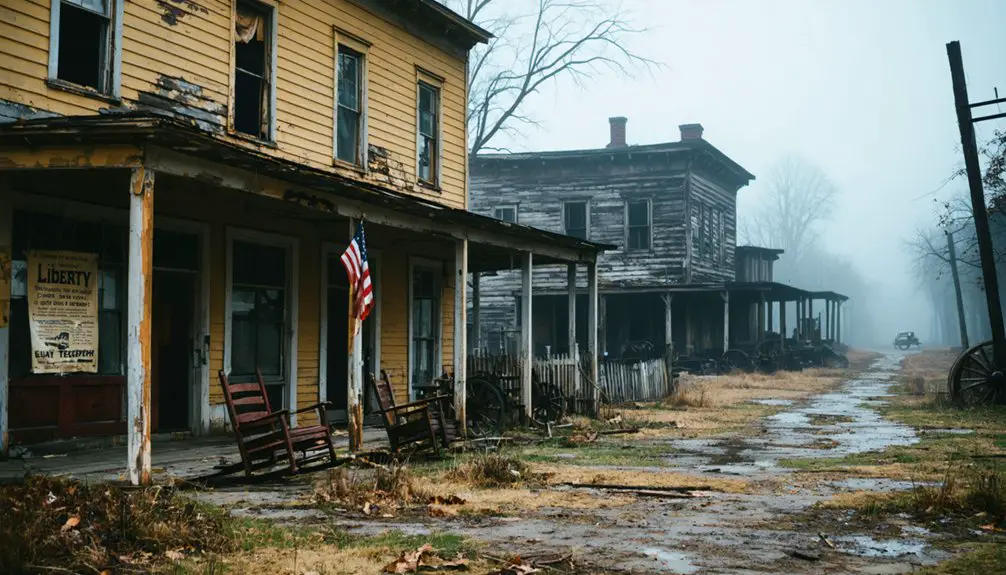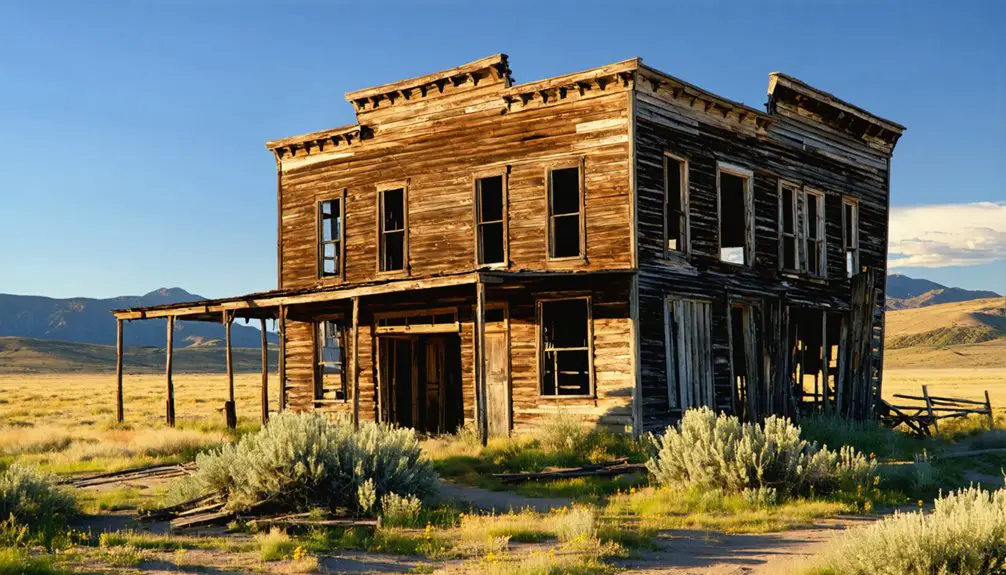You’ll find Kennedy’s ghost town ruins nestled in Washington state, where pioneers settled in the 1850s during the westward migration. The settlement flourished during the 1870s Gold Rush, with miners earning $2.50 daily in the dangerous 5,900-foot mine shafts that earned it the nickname “Widowmaker.” Today, you can explore the preserved structures and industrial artifacts, though the site’s most intriguing story lies in its secret role as John Brown’s covert abolitionist headquarters.
Key Takeaways
- Kennedy, Washington was established in the mid-19th century during westward migration, with Lewis Hawkins Davis claiming land around 1851.
- The town thrived during the 1870s Gold Rush, featuring extensive mining operations including remarkable 5,900-foot mine shafts.
- Dangerous mining conditions earned Kennedy the nickname “Widowmaker,” contributing to its eventual abandonment and ghost town status.
- The site contains significant industrial mining remnants and underground infrastructure that distinguish it from typical ghost towns.
- Visitors can explore historic structures and ruins but must follow safety precautions and environmental guidelines when visiting the site.
The Historical Origins of Kennedy Settlement
When westward migration brought settlers to the Pacific Northwest in the mid-19th century, the area that would become Kennedy, Washington began attracting its first pioneer residents.
Following the model of nearby settlements like Claquato, pioneers like Lewis Hawkins Davis arrived around 1851, establishing Donation Land Claims for homesteading in the partly timbered terrain. Most settlers earned a daily wage of $2.50 working in nearby mines rather than striking it rich themselves.
Early settlers staked their claims across the Pacific Northwest’s wooded lands, following established patterns of homesteading in the 1850s.
You’ll find the landscape was already rich with indigenous history, as Native American tribes had long used the area for seasonal camping and hunting.
Their established trails and burial grounds shaped pioneer settlement patterns, with many early roads following these traditional pathways. Similar to the town of Liberty, the region experienced a significant economic boost during the state’s Gold Rush in the 1870s.
The natural features that drew indigenous peoples – including essential waterways for fishing and transport – proved equally attractive to settlers, who adapted these resources for their own survival and growth.
John Brown’s Secret Base and Strategic Planning
You’ll find that Kennedy Farm served as John Brown’s covert operations center in 1859, where he and 21 men stockpiled weapons while planning their raid on the federal arsenal at Harpers Ferry.
The two-story log cabin became a militia training ground where Brown’s men studied battle maps, practiced military maneuvers, and concealed approximately 200 Sharps rifles and 1,000 pikes in preparation for their assault.
The farmhouse functioned as a strategic hub for the abolitionist movement, with Brown’s daughters maintaining the secrecy of their mission by acting as lookouts and performing domestic duties while the men hid in the attic during daylight hours. Brown operated under the alias Isaac Smith while renting and organizing operations at the farmhouse. Brown secured the property by paying $35 in gold to rent the farmhouse as his base of operations.
Covert Operations Planning Base
Through the early 1960s, the Kennedy administration established an intricate network of covert operations bases to support Operation Mongoose, with Miami’s JM/WAVE station serving as the primary nerve center for anti-Castro activities.
Under Robert Kennedy’s supervision, strategic planning emphasized coordinated efforts between CIA and military assets. The federal government owned the facility until 1986, maintaining strict security protocols throughout the Cold War period.
The operation’s sophisticated command structure included:
- Expanded facilities at Opa Locka for intelligence debriefings and mission planning
- A fleet of repurposed Landing Craft Infantry vessels for covert insertions
- Multiple command posts supporting operational logistics and supply caches
You’ll find that General Lansdale’s framework divided operations into six escalating phases, culminating in planned Cuban revolt by late 1962. The operation required a significant financial commitment, with an initial CIA budget of $13.8 million proposed for fiscal year 1962.
The covert operations integrated lessons from the Bay of Pigs, focusing on sustainable guerrilla support and intelligence dominance while maintaining adaptability to shifting political conditions.
Militia Training Ground Details
During the months leading up to the 1859 Harpers Ferry raid, John Brown established a sophisticated militia training ground at Kennedy Farm, operating under the alias “Isaac Smith” to maintain secrecy.
You’ll find that militia tactics centered on weapons proficiency, with 21 men training extensively with Sharps rifles and hand-thrust pikes while confined to the attic during daylight hours.
The training methods included detailed map studies of the surrounding geography and close-combat drills with edged weapons.
Brown’s integrated force of white and Black fighters, including notable members like Lewis Sheridan Leary and Shields Green, prepared for coordinated armed resistance.
They’d stockpiled approximately 200 Sharps rifles and hundreds of pikes, while Brown’s family maintained the farm’s innocent appearance, greeting or deflecting curious neighbors to protect the covert operation.
The average age of 25 among Brown’s followers reflected the youthful determination of his revolutionary force.
Local residents were kept unaware of the true purpose through a cover story about mining activities in the area.
Abolitionist Movement Strategic Hub
Kennedy Farm emerged as the nerve center of John Brown’s revolutionary abolitionist campaign in the summer of 1859. Under the alias Isaac Smith, you’ll find that Brown transformed this two-story farmhouse into a clandestine headquarters just seven miles from Harpers Ferry.
His abolitionist tactics centered on three core elements:
- Stockpiling weapons, including guns and pikes, to arm enslaved recruits
- Conducting intensive intelligence gathering and strategic planning under cover of darkness
- Maintaining strict operational security through daytime attic concealment
This strategic hub represented a radical shift in insurrection strategies, as Brown and his followers prepared to ignite a nationwide uprising. The mission ultimately ended in eighteen deaths during the failed raid on October 16-17, 1859.
Their goal wasn’t just to raid the federal arsenal – they aimed to establish a slave republic and fundamentally disrupt the institution of slavery through armed resistance. Like Kennedy’s own phased approach to abolition, Brown’s radical methods represented one extreme in the spectrum of anti-slavery activism.
Architectural Evolution and Preservation
You’ll find Kennedy’s earliest buildings constructed on simple stone and timber foundations, utilizing locally sourced materials and pioneer-era construction methods common to the mid-1800s Pacific Northwest.
Through later decades, the town’s structures evolved with more sophisticated additions, including Greek Revival elements in community buildings and expanded commercial spaces during the lumber mill period.
Recent preservation work has focused on historically accurate restoration techniques, incorporating period-appropriate materials and craftsmanship while stabilizing structures against the region’s challenging weather conditions.
Original Foundation Details
Deep within Washington’s pioneer-era landscape, the original foundations of Kennedy stand as evidence to practical frontier architecture and resourceful settlement planning.
You’ll find foundational architecture that reflects the resourceful spirit of early settlers, who utilized local timber and stone to establish their community.
The settlement layout followed a purposeful design incorporating:
- A practical grid system optimizing transport and land use
- Strategic placement near water sources for milling operations
- Integration of natural terrain features for sustainable development
Kennedy’s original structures showcased the pioneers’ adaptability, with foundations built from rough-hewn timber pilings and local stone.
These architectural elements supported multifunctional buildings that served both residential and commercial needs, while public spaces centered around main thoroughfares created a cohesive community design that balanced practicality with frontier living.
Later Structural Additions
As the mining town evolved beyond its pioneer roots, significant structural additions transformed Kennedy’s architectural landscape through a calculated mix of stone, concrete, and rail infrastructure.
You’ll find evidence of this evolution in the large stone walls added to existing structures, with concrete caps poured on top for enhanced structural durability. The town’s shift toward industrial functionality is apparent in the remnants of railway trestles and heavy equipment supports anchored throughout the site.
Original wooden buildings gave way to more robust materials as operations expanded.
You can trace this progression through surviving brick elements, integrated piping systems, and stone wall modifications that created specialized operational zones. These adaptations reflect Kennedy’s transformation from a simple settlement into a mechanized mining operation focused on efficient material processing and transport.
Restoration Techniques Applied
Through meticulous conservation efforts, Kennedy’s historic structures have undergone careful restoration using period-appropriate materials and techniques.
You’ll find preservation challenges addressed through historically accurate methods that maintain the town’s authentic character while ensuring structural stability.
Key restoration methods implemented include:
- Application of lime-based mortars on masonry walls to preserve breathability and manage moisture
- Installation of concealed steel supports to reinforce original timber framing without compromising appearance
- Reproduction of missing architectural elements using documented historic profiles and joinery techniques
The restoration team’s utilized archival research and modern documentation technologies to guide their work.
They’ve carefully managed the surrounding landscape to prevent erosion and root damage while retaining the ghost town’s historic setting and character-defining features.
Notable Differences From Pacific Northwest Ghost Towns
Compared to other abandoned settlements in the Pacific Northwest, Kennedy stands apart through its extensive underground infrastructure and industrial mining remnants.
While typical Washington ghost towns feature decaying wooden structures like schoolhouses and post offices spread across the surface, Kennedy’s legacy lies in its remarkable 5,900-foot mine shafts and heavy mining infrastructure.
You’ll find that economic decline affected these places differently too.
Where Pacific Northwest towns often failed due to railroad changes or reduced farming viability, Kennedy’s downfall stemmed from specific challenges in deep gold mining operations.
While railroad shifts and farming decline emptied many Pacific Northwest towns, Kennedy’s fate was sealed by the harsh realities of deep mining.
The site earned its “Widowmaker” nickname from dangerous conditions, yet mining persisted longer here than in many Washington boom towns.
Today, Kennedy’s industrial artifacts and deep tunnels create a more concentrated historical footprint than the scattered surface ruins typical of Pacific Northwest ghost towns.
The Role of Kennedy in Pre-Civil War America

Kennedy Farm’s historical significance extends far beyond its Washington County, Maryland location, taking center stage in one of America’s most dramatic pre-Civil War episodes.
Under the alias Isaac Smith, John Brown transformed this modest farmhouse into the headquarters of militant abolitionism, demonstrating its strategic significance in the fight against slavery.
The farm’s role in pre-Civil War America centered on three key aspects:
- Serving as a covert operations center where Brown and 21 followers planned the Harpers Ferry raid
- Functioning as a weapons depot storing guns and pikes intended to arm enslaved recruits
- Representing the shift from peaceful protest to armed resistance in the abolitionist movement
You’ll find the farm’s preserved structure still stands today as a National Historic Landmark, commemorating this pivotal moment in America’s journey toward freedom.
Restoration Efforts and Heritage Protection
While preserving historical landmarks requires substantial resources, the restoration of the John Brown farmhouse exemplifies successful collaboration between federal, state, and private entities.
You’ll find that community involvement plays a vital role, with local advisory committees guiding restoration decisions and public engagement priorities.
The project draws from diverse funding sources, including state preservation grants, federal historic preservation programs, and private donations.
The Maryland Historical Trust oversees historical accuracy and restoration methodology, ensuring proper structural reinforcement and landscape preservation.
They’ve balanced modern safety requirements with original construction methods while maintaining site integrity.
You can now participate in prearranged small-group tours that help generate operational funds.
The site’s interpretation efforts focus on abolition history, with tax-deductible donations supporting ongoing preservation and educational initiatives.
The Legacy of Maryland’s Abolitionist Haven

Maryland’s complex relationship with abolition emerges through the story of the Kennedy Farm, where abolitionist John Brown planned his infamous 1859 Harper’s Ferry raid.
You’ll find this pivotal site’s impact on Maryland history reflected in the state’s growing abolitionist movement, which faced fierce opposition from tobacco planters and pro-slavery advocates.
The abolitionist impact manifested in three key ways:
- The farm’s role as a secret headquarters housed 21 men and stockpiled weapons.
- Brown’s raid intensified the state’s political divide, ultimately contributing to Maryland’s 1864 abolition vote.
- The site’s legacy symbolizes the escalating tensions that pushed Maryland toward emancipation.
During this period, you’d have witnessed increasing slave resistance and escapes, while wartime pressures steadily eroded planter authority throughout the state.
Visiting and Exploring Kennedy Today
Today’s visitors to this remote Washington ghost town will find a challenging but rewarding destination accessible through a network of back roads near former Northern Pacific Railroad lines.
You’ll need to prepare for rugged terrain and limited signage as you venture into this historic mining site.
During your ghost town exploration, you’ll discover remnants of the past, including deteriorating cabins, mining machinery, and railroad beds that have been converted to hiking trails.
You’ll want to bring adequate supplies, including water, food, and first aid equipment, as cell service is unreliable. Weather can change quickly, so pack layers and waterproof gear.
While mining shafts and tunnels exist, they’re unsafe to explore without expert guidance. For the best experience, inform others of your plans and focus on photographing the historic structures and surrounding landscape.
Frequently Asked Questions
What Happened to Robert F. Kennedy’s Immediate Family After His Death?
Like a fortress against time, you’d see RFK’s Kennedy legacy endure through Ethel raising their 11 children alone, with family impact rippling through generations of public service, despite losing sons David and Michael.
Were There Any Documented Escapes of Enslaved People Through Kennedy’s Property?
You won’t find documented evidence of fugitive routes or enslaved narratives through Kennedy’s property in Washington state. Historical records show it was primarily a logging town far from typical escape corridors.
What Crops or Livestock Were Maintained on Kennedy’s Farm?
You’ll find familiar crop varieties like potatoes, wheat, peas, and hay alongside common livestock types including cattle, hogs, sheep, and horses – all typical for Washington’s early diversified farming practices.
Did Local Residents Support or Oppose John Brown’s Presence?
You’ll find most locals opposed Brown’s influence, as he operated in secrecy using aliases and cover stories. Community reactions were largely hostile or indifferent, with no evidence of organized local support.
Are There Any Surviving Artifacts or Documents From Kennedy’s Original Home?
You’ll find surviving mining equipment and mill structures but no confirmed artifacts or documents from Kennedy’s original home. Historical preservation efforts focus on industrial remains rather than domestic artifact recovery.
References
- https://johnbrown.org
- https://stateofwatourism.com/ghost-towns-of-washington-state/
- https://www.wta.org/go-outside/seasonal-hikes/fall-destinations/hidden-history-ghost-town-hikes
- https://www.atlasobscura.com/places/barron-ghost-town
- https://www.lewistalk.com/2017/10/07/rich-history-onalaska/
- https://www.lewistalk.com/2018/07/15/ghost-town-claquato-washington/
- https://www.atlasobscura.com/places/kennedy-gold-mine-california
- https://pnwadventuresisters.wordpress.com/2018/01/30/fortson-mill-ghost-town/
- https://www.nps.gov/places/kennedy-farm.htm
- https://www.railstotrails.org/trailblog/revisiting-john-browns-raid-on-harpers-ferry/



